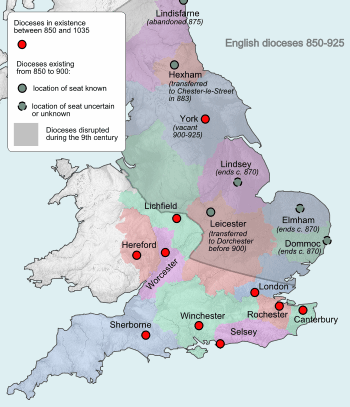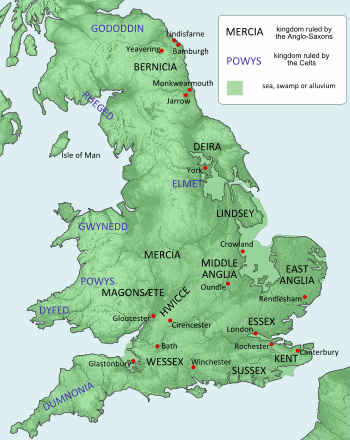Ealdwulf of East Anglia
| Ealdwulf | |
|---|---|
| King of the East Angles | |
| Reign | 663 - about 713 |
| Predecessor | Æthelwold |
| Successor | Ælfwald |
| Died | 713 |
| Issue | Ælfwald |
| Dynasty | Wuffingas |
| Father | Æthilric |
| Mother | Hereswitha |
| Religion | Christian |
Ealdwulf (or Aldwulf) was king of East Anglia from 663 to around 713. His forty-nine year reign was extraordinary in length, with only Æthelbald of Mercia and Offa of Mercia having comparable longevity. Little is known of Ealdwulf, but his long rule reflects the success of alliances formed in the decades before his ascension. During his reign, East Anglia experienced a long period of stability and growth, not least in its commercial centre at Gipeswic (now modern Ipswich).
Origins and childhood
Ealdwulf was the son of Æthilric and the grandson of Eni. He belonged to the East Anglian Wuffingas dynasty, who ruled the kingdom of East Anglia (Old English: Ēast Engla Rīce), a small independent Anglo-Saxon kingdom that comprised what are now the English counties of Norfolk and Suffolk and part of the Fens.[1][2] His father Æthilric may have been the same person as Ecgric,[3] an East Anglian king who was killed in battle around 636.[4] His mother Hereswith, who was the daughter of Hereric and Breguswith (a nephew of Edwin of Northumbria}, belonged to the Northumbrian royal family.
Soon after becoming king in 616, Edwin killed Ceretic of Elmet, following the murder of Hereswith's exiled father. Hereswith may have been baptized as a child by Paulinus of York in 626, along with her sister Hilda, Edwin and other members of the Northumbrian royal family. The diplomatic marriage of Æthilric and Hereswith occurred between 626 and 633, before Edwin was himself slain by Cadwallon ap Cadfan, and must have carried the expectation that Æthilric was to be a Christian husband and probably king of the East Angles. It sealed Æthilric in kinship to Edwin.
During Ealdwulf's childhood, Felix of Burgundy and Fursey were both active in East Anglia.[5] As a boy, Ealdwulf is said to have seen for himself the temple containing both Christian and pagan altars that Rædwald of East Anglia had maintained.[6] Ealdwulf's testimony may be the authority for Bede's account of the temple. Æthilric died before around 647, after which his widow left for Gaul to lead a religious life within the Frankish royal oratory at Chelles, there being at that time no religious house for women in East Anglia. It is not known whether Ealdwulf accompanied his mother, or whether he remained in East Anglia during the eventful reigns of his three uncles — Anna, Æthelhere and Æthelwold. It is likely he stayed in East Anglia and acted as an ealdorman/nobleman warrior, since in 647, when Hereswith left for Gaul, he would have already been around 20 years of age.
Reign
Ealdwulf, who became king in 663, is the last king of East Anglia that Bede knew about.[7] At the start of his reign, a great plague swept across the Anglo-Saxon kingdoms. At one point during this period, Boniface of Dommoc was the only English bishop whose consecration was derived from Canterbury. He himself died in (or shortly before) 669. King Anna of East Anglia's daughter Æthelburg, the abbess of Faremoutiers Abbey, probably died of the plague at this time and was succeeded by her half-sister Sæthryth.
In 669, Pope Vitalian sent Theodore of Tarsus and his assistant Hadrian to Canterbury, where Ecgbert, son of Eorcenberht of Kent, was king. Theodore established a great school and began to reform the English Church. Bisi was appointed Bishop of Dommoc. At York he created Wilfrid Bishop of Northumbria, removing Chad, who went first to Lastingham as abbot and then as bishop to Lichfield in Mercia. Oswiu of Northumbria died in 670 and was buried near Edwin at Whitby: his widow Eanfled also retired to live under the abbacy of Hild, Ealdwulf's maternal aunt. Oswiu's successor was Ecgfrith, whose wife Etheldreda remained a virgin.
Monastic patronage and division of the diocese

In 672, Etheldreda took religious vows with the help of Bishop Wilfrid, to whom she gave the estate at Hexham, and after a year escaped to her East Anglian estate of Ely, where she founded a double monastery, the origin of the great mediaeval abbey. Meanwhile, in Kent, her nephew Ecgberht established the monastery of Minster-in-Thanet, ruled by his cousin Eormenburga, Merewalh's queen. In 673, Ecgbert was succeeded by his brother Hlothhere and their mother Seaxburga, Etheldreda's sister, became established in her double monastery at Minster-in-Sheppey in the Isle of Sheppey.
The governance of Ely and Sheppey under two queens of East Anglian birth created an enduring axis of patronage and influence. Theodore notified Ecgfrith that he could not remarry within the Church while Etheldreda was living, denying him a legitimate heir. Soon afterwards, with Bishop Bisi in declining health, he divided the bishopric of Dommoc, creating a second East Anglian seat in Norfolk at North Elmham, or at South Elmham, in Suffolk). Bishop Æcci was appointed to Dommoc and Baduwine to Helmham. Abbot Botolph died in 674 at Iken and was succeeded by Æthelheah, who later exchanged land-rights with the monastery of Much Wenlock in Shropshire. These entails had perhaps been bestowed by Anna at the foundation of Iken, through his daughter Seaxburga's kinship to the family of Merewalh and Eormenburga.
It is suggested, but unproved, that the revenue of the East Anglian royal estates centred upon Rendlesham (the 'Five-and-a-half Hundreds', or Wicklaw) were bestowed upon Ely at its foundation, since they formed the largest share of Bishop Æthelwold of Winchester's re-endowment of Ely in around 970, which later became known as the 'Liberty of St Etheldreda'. Similar doubt surrounds the Papal Privileges later claimed to have been obtained at Rome by Wilfrid in around 680 for Ely and Peterborough. If either or both were authentic, they would show a decisive policy of Ealdwulf to reinforce dynastic authority through ecclesiastical structures. Wilfrid retained close contacts with Ely and Peterborough from his monastery at Oundle. Etheldreda and Hild both died in around 680: Seaxburga transferred to Ely, leaving Sheppey to Eormenhilda.
Influence in Lindsey

The name and dynastic house of Ealdwulf's queen is unknown. They had at least two children, his heir Ælfwald and Ecgburga, who later became an abbess. The marriage probably coloured East Anglia's dealings with Mercia and Northumbria, which were approaching new confrontations. When Wulfhere of Mercia died in around 675, his widow Eormenhilda joined her mother at Minster-in-Sheppey and his brother Aethelred, whose wife Osthryth was daughter of Oswald of Northumbria, succeeded to the throne. Since Raedwald's time the rule of the Kingdom of Lindsey had been disputed between Mercia and Northumbria, but after a battle in 679 it fell finally to Mercia. East Anglia increasingly acknowledged the superior influence of Mercia.
Coinage and commerce
The issue and use of English coins during Ealdwulf's reign followed its development in Kent, at first with gold shillings or thrymsas during the 660s to the 670s, and thereafter, by a debasement linked to the diminishing gold quality of Frankish coin, with silver sceattas or pennies of various types. The distribution of findspots reveals foci of their use and possibly their issue at East Anglian centres of importance, especially in the north-west around Hunstanton, Bawsey in the Thetford area, the Fen edge around Isleworth and Exning, in the east around Burgh Castle, and in the area around Rendlesham, Ipswich and in the River Gipping valley.
The status of coinage was not yet as a true currency, nor overtly regnal. The pieces attributed to East Anglian production are found alongside others mainly of Kentish, East Saxon, and Frisian or Netherlandish types, reflecting external communications with those centres. In the same period Gipeswic witnessed the full development of its first major expansion from the quayside north to the Cattlemarket area, with established production of Frisian-inspired Ipswich Ware pottery to the north-east of this area. Its continental trade partners may have been Domburg in Walcheren and Dorestad, the large emporium on the Rhine south of Utrecht. This route gained importance as the Christian mission to Frisia developed from the 680s.[8]
Conflict with Wessex
In 685 two events strengthened Mercia's power: Kent was plunged into a civil war in which Hlothhere perished, and Ecgfrith of Northumbria was killed in an expedition against the Picts. Ealdwulf is one of three Anglian kings, along with Æthelred of Mercia and Aldfrith, who were addressed by Pope Sergius in a letter of 692 urging their acceptance of Berhtwald of Reculver as the successor to Theodore at Canterbury. Soon afterwards, Kent was twice invaded by Caedwalla of Wessex: during the first invasion, his brother Mul was captured and burnt to death along with his bodyguard. Caedwalla abdicated to lead the life of a monk. While Ecgbert's son Wihtred took possession of Kent, Ine began his reign in Wessex. It is possible that Ealdwulf assisted Kent against Wessex. In 693-694 Ine obliged Kent to pay recompense for Mul's death, but also, according to William of Malmesbury, banished the East Anglian nobility and then put them to flight in battle. This perhaps occurred in Kent, since Ealdwulf was not overthrown.
Relations with Mercia
East Anglian patrimony was restated at Ely in 696, when Seaxburga translated the uncorrupt remains of Etheldreda into the monastery church. Seaxburga died in 699 and was succeeded at Ely by Eormenhilda. Mercia's power in Lindsey was affirmed at the royal monastery of Bardney, beside Lincoln: Queen Osthryth had her father Oswald's relics enshrined there, but was slain by the Mercian people in 697. Æthelred abdicated and retired to Bardney in 704 and was succeeded by his nephew, Coenred, the son of Wulfhere and Eormenhilda. Their daughter Werburga united the Mercian lines by marrying Æthelred's son Ceolred. The subsidiarity of the East Saxons to Mercia is shown in charters of Coenred, and found an amicable settlement when Coenred and Offa of Essex abdicated together and went to Rome to lead religious lives in 709. Ealdwulf's position was protected by the complete investment of his kin in the surrounding dynasties and their patronage of leading religious houses.
The closing years of Ealdwulf's reign were coloured by the unsatisfactory rule of Ceolred, who depleted monastic assets to support his style of kingship. At this time the Mercian royal hermit Guthlac was living on the island of Crowland.[9] His secluded fenland retreat became a place of refuge for a Mercian royal counter-claimant, Æthelbald, who appears to have received encouragement and protection there from the East Anglian nobility. However this development, extremely important in its outcome, had not fully unfolded when Ealdwulf died in 713, leaving his son Ælfwald to succeed to the East Anglian throne.
Footnotes
- ↑

- ↑ Yorke, Kings and Kingdoms, p. 68
- ↑ Hoggett, The Archaeology of the East Anglian Conversion, p. 25.
- ↑ Kirby, The Earliest English Kings, p. 74.
- ↑ Warner, Origins, pp. 109, 111-112.
- ↑ Bede, Historia ecclesiastica gentis Anglorum 2.15
- ↑ Yorke, Kings and Kingdoms, p. 63.
- ↑ Warner, Origins, p. 74.
- ↑ Pestell, Landscapes of Monastic Foundation, pp. 54-55.
Sources
- Hoggett, Richard (2010). The Archaeology of the East Anglian Conversion. Woodbridge, UK: The Boydell Press. p. 28. ISBN 978-1-84383-595-0.
- D. P. Kirby (2000). The Earliest English Kings. London and New York: Routledge. ISBN 0-415-24211-8.
- Pestell, Tim (2004). Landscapes of Monastic Foundation: The Establishment of Religious Houses in East Anglia, c.650-1200. Woodbridge: Boydell Press. ISBN 1-84383-062-0.
- Warner, Peter (1996). The Origins of Suffolk. Manchester and New York: Manchester University Press. ISBN 0-7190-3817-0.
- Yorke, Barbara (2002). Kings and Kingdoms of Early Anglo-Saxon England. London and New York: Routledge. ISBN 0-415-16639-X.
External links
| English royalty | ||
|---|---|---|
| Preceded by Æthelwold |
King of East Anglia 664 – 713 |
Succeeded by Ælfwald |